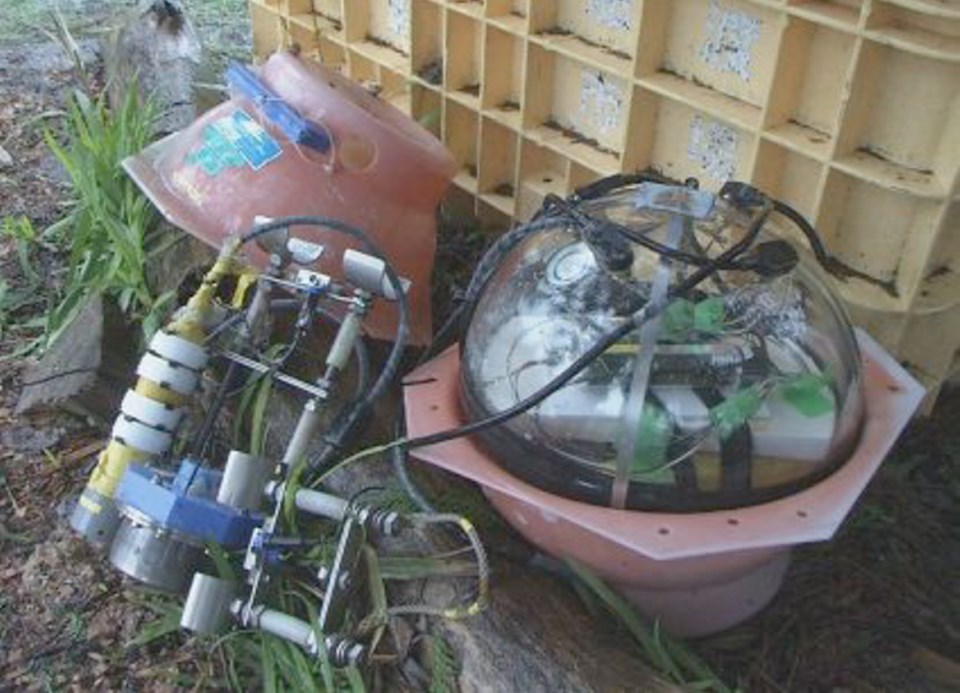SEATTLE ŌĆö When Jerry Paros shipped a seafloor sensor from his plant in Redmond to Japan in 2010, he never expected to see it again.
And when Tohoku University geophysicist Ryota Hino deployed the device off the coast of Hokkaido that July, his only expectation was that it would help him gather data about a dangerous, underwater fault.
But last month, the two men found themselves at the headquarters of Paroscientific Inc., along with a Japanese television crew, examining the battered ŌĆö but intact ŌĆö instrument and marveling at the long, strange trip across the Pacific that brought it back to its birthplace.
ŌĆ£It was an amazing moment,ŌĆØ said Paros, who started the sensor business in his home in 1972. ŌĆ£ItŌĆÖs like Lassie came home.ŌĆØ
The instrumentŌĆÖs journey began after the 2011 megaquake and tsunami that claimed 18,000 lives and battered a vast swath of JapanŌĆÖs coastline.
The Paroscientific pressure gauge was one of five that Hino and his colleagues had tethered to the seafloor in 1.6-kilometre-deep water.
Their goal was to monitor strain and motion on a submarine fault, called a subduction zone, that threatens JapanŌĆÖs northernmost island.
It was a different subduction zone that ripped on March 11, 2011, about 500 kilometres south of HinoŌĆÖs array.
But he figured there was a good chance the sensitive gauges recorded the tsunami as it swept through before slamming into the Hokkaido coast.
So Hino and his colleagues returned to the area by ship four months later to see if the instruments survived and retrieve any stored data.
They recovered all but one of the pressure sensors, which were designed to detach from their moorings when signalled and be lofted to the surface by a buoyant glass float.
The missing sensor sent out an acoustic response when pinged but failed to surface, Hino explained.
ŌĆ£My guess is that the hard shaking from the earthquake generated some kind of mud flow, and the instrument got stuck in the mud,ŌĆØ he said.
At some point, the apparatus worked its way free. Buoyed by the glass sphere, it began to drift ŌĆö following the path of five million tons of broken docks, splintered homes, tangled nets and childrenŌĆÖs toys that collectively came to be called tsunami debris.
And thatŌĆÖs where Phil Stamp comes into the story.
The manager of an oyster farm on Willapa Bay, Stamp is a veteran beachcomber. A few weeks before Christmas 2014, he was cruising the beach in his pickup when he spotted something pink at the edge of the waterline.
He could see it was a glass float encased in a plastic shell ŌĆö but he didnŌĆÖt know what to make of the tangle of instruments inside the sphere or the metal cylinder attached to it. ŌĆ£It was covered with gooseneck barnacles,ŌĆØ Stamp recalled. ŌĆ£It weighed so much with all that junk on it I had to take my tailgate off and slide it up into the truck with a rope.ŌĆØ
Once he cleaned it, Stamp could see that the device was valuable. ŌĆ£I knew someone was going to want it more than me.ŌĆØ
He enlisted a fellow beachcomber, who has reunited other Japanese debris with its owners, and a months-long email quest ensued.
The message didnŌĆÖt get to Hino until the following summer.
ŌĆ£I was really surprised,ŌĆØ he said. ŌĆ£This instrument is very important to us.ŌĆØ
Not only was there a chance it held precious data about the tsunami ŌĆö it also cost almost $30,000 US. So Hino decided to come to Washington and fetch it.
A documentary crew from NHK, JapanŌĆÖs public broadcaster, accompanied him to film the story for a documentary episode called Raging Earth II: Giant Earthquakes, scheduled for release around the fifth anniversary of the quake and tsunami.
The cameras were rolling on the blustery day when Hino and the instrument were reunited.
ŌĆ£When I pulled back the tarp, the professorŌĆÖs eyes were like a little kid on Christmas,ŌĆØ Stamp said.
But an even bigger surprise was in store.
Hino brought the instrument to Paroscientific, where tests showed that though the battery was dead, the sensor was fine.
ŌĆ£We hooked it up and to everyoneŌĆÖs amazement, it was perfect,ŌĆØ Paros said.
The data recorded during the tsunami is also intact.
ThatŌĆÖs great news, Hino said, because most of the other pressure sensors were so badly damaged that little data was recovered.
Since the 2011 megaquake and tsunami, Japan has invested heavily in seafloor instruments to monitor subduction zones. Nearly 1,000 of ParoscientificŌĆÖs pressure gauges are deployed in networks around the islands.
Some of HinoŌĆÖs other sensors helped reveal that the seafloor moved nearly 60 metres in places during the magnitude-9 quake, which is one reason the tsunami was so huge.
His sensors and others also captured evidence that the fault had been slipping slowly in the days before the quake.
That raises the intriguing possibility that monitoring might someday detect warning signs before major quakes.



